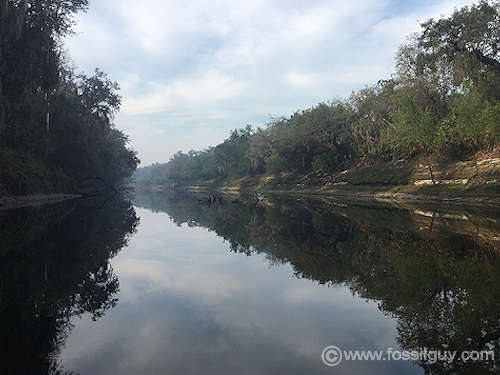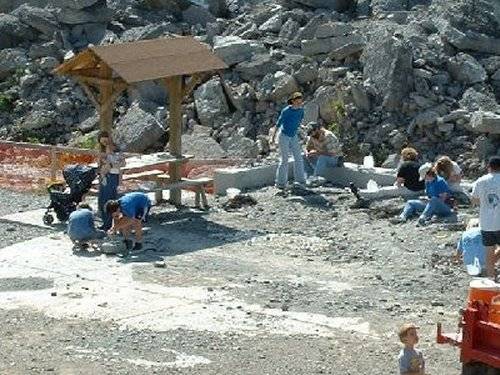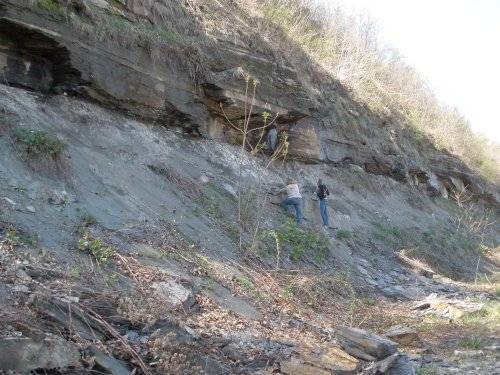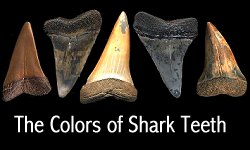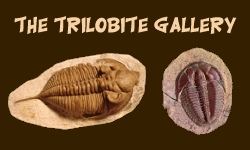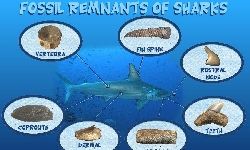Article written by: Jayson Kowinsky - Fossilguy.com
What is a Fossil?
Fossil Facts and Information

What is a Fossil?
A fossil is the remains or evidence of a plant or animal that lived in the past.
Fossils are an important part of the Earth's history and have helped scientists learn about the evolution
of life on our planet. They are often studied in the field of paleontology,
which is the study of the history of life on Earth.
How do Fossils Form?
Fossils usually only form in sedimentary rock. They form when the remains of an organism are buried in sediment,
such as sand or mud. Over time, minerals in the ground harden the sediment and replaces the organic material in the remains.
Most fossils form in environments with water since sediments
easily accumulate in water environments (lakes, streams, oceans). Land environments are usually the sites
for erosion and not sediment deposition.
Let's look at an example of a leaf falling into a river.
The leaf falls into the river, floats downstream, and sinks to the bottom. It's then covered by silt and sand over then next few days.
As more time passes, more and more sediment covers it. Each layer of sediment increasingly protects the leaf from decay.
Now, multiply the time frame by an unimaginable number of years.. millions of years. Instead of
the leaf being buried by a few inches of sediment, it is buried by miles and miles of sediment! Something
now begins to happen to that sediment. Under miles and miles of pressure it heats up and the leaf literally cooks.
Only the carbon ash remains. Chemical processes start to occur under the tremendous pressure, and the sediments compact into a type of rock... sedimentary rock.
Now, add millions of more years. Geologic forces thrust that sedimentary
rock back onto the surface. Wind and weather take its toll. The sedimentary rock outcropping begins to erode away.
In one of the pieces of the eroded rock outcropping falls a fossil leaf impression. That was the leaf that fell into a river millions of years ago.
This is how fossils form.
This wonderful animated gif below that has circulated around the web shows this process. Instead of a leaf, it uses a dinosaur.
Types of Fossils and Modes of Fossil Preservation
There are many different types of fossils, and they can be found in a variety of forms. Some of the main types of fossils include: Casts and Molds, Permineralization, Replacement, and Carbonization. Sometimes the fossil is unaltered, meaning it is the actual organism.
Fossil Casts and Molds:

Fossil Turitella shells from the Potomac River. They have been preserved as Casts when sediment filled in the shells. When they pop out of the sedimentary rock, a mold is left.
When an organism's remains are buried in sediment, the shape of the remains can be preserved as a mold.
A cast is created when the mold is filled with a different material,
such as sediment or minerals. Molds and casts can preserve the shape of an organism, but not the details of its structure.
This is like pouring chocolate into a mold.
When the chocolate hardens, it pops out as a chocolate cast, ready to eat.
Examples of Casts and Molds:
Fossil shells are often casts, and shell impressions on rock are often molds.
Trilobites are often found as casts and molds.
Permineralization and Replacement:

This fossil dolphin vertebra from the
Calvert Cliffs of MD has
been preserved through permineralization.
The minerals that replaced it gives it a beautiful rusty-brown color.
These fossils form when minerals, such as silica or calcite, fill the spaces within an organism's remains and preserve the details
of the original material. Permineralized fossils include petrified wood, which is wood that has been turned to stone,
and fossilized bones, which have been replaced by minerals.
Many fossils are preserved this ways, from Fossil shark teeth to fossil bones.
Carbonization:

These plant fossils slabs from St. Clair were carbonized.
However, through complicated oxidation and replacement reactions, the Pyrite replaced the
carbon and then a white substance called Pyrophyllite replaced the Pyrite. Now the fossils have a white film instead of a black carbon film.
These fossils are created when the remains of an organism are subjected to high pressure and heat,
which causes the organic material to be converted into a carbonized form. Carbonized fossils include coal,
which is formed from the remains of ancient plants, and amber, which is fossilized tree resin that has trapped insects or other small organisms.
Carbonization is the process where only the residual carbon of the organism remains. In nature this happens when an organism
is subject to heat and pressure.
A very common example of carbonization are fossil plants, where only a thin carbon layer is left on a piece of shale.
In the Carboniferous time period, fast fern forests created miles of carbon, which we mine today as coal.
Another, example are the fossilized feathers found on dinosaurs in China. These are left as carbon imprints in the shale around the mineralized dinosaur bones.
Unaltered remains:

This is a fossil Saber Toothed Cat from the La Brea Tar Pits in Los Angeles. The skeleton is the original Unaltered Remains.
The animal fell in the tar. The bones are original and are stained a brown color from the tar.
An organism is considered unaltered if there is no change in the original composition of the organism.
A famous example of this is found at the La Brae Tar Pits in Los Angeles. Here, Ice Age animals became trapped and sunk
into the tar pits. The soft tissues rotted away, but the original bones still remain. Original bones from Saber Toothed Cats,
Giant Ground Sloths, Short Faced Cave Bears, Dire Wolves, and many more strange creatures are all unaltered.
Another example includes insects and small animals trapped in Amber. The sap from a once living
tree entombed the animals. This sap eventually hardened, and the original animals are preseved inside the amber.
Trace Fossils (Ichnofossils):

These are fossil "foot" prints of a giant Eurypterid, a Sea Scorpion. The prints are a trace of the animals activity. Casts and Molds of Footprints are called Trace Fossils
Trace Fossils, or Ichnofossils, are not the remains of an organism, but rather evidence of their presence or activities. Trace fossils include footprints, burrows, and other marks left by animals.
Coprolite: Fossil Poop!
This is poop... Yes, Fossil Poop. Even poop can fossilize! A piece of fossil poop is called a Coprolite.
Coprolite is classified as a Trace Fossil. These fossils can tell us all about the diet and ecology of the animal!
The Coprolites pictured here are from from a cretaceous Super Crocodile.
Recommended Gear and Books for Fossil Hunting
Where to Find Fossils
It takes a unique set of circumstances to preserve a fossil and then to re-expose it for us to find.
Fortunately, since there have been so many life forms over countless years, fossils are more common than one may think.
Most sedimentary rock outcroppings contain fossils.
Fossils can be found in places opposite as how they form, in places of erosion.
To find fossils, one needs to look in sedimentary rock outcroppings. Other types of rock, such as granite are not formed by
sediments accumulating, so animals will not be preserved in them. Sedimentary rock includes sandstone, shale, mudstone, limestone, and clay.
Included here are some well known places to find fossils.
This website has an entire section devoted to Fossil Collecting Location. For a complete list of fossil collecting sites,
go to the FOSSIL SITES SECTION
CALVERT CLIFFS OF MARYLAND
This fossil collecting location contains Miocene marine fauna, including fossil shark teeth.
It's a nice location because the collecting is done by beachcombing along the Chesapeake bay. It is a very family friendly place to look for fossil shark teeth.
PEACE RIVER, FLORIDA
This is a nice fossil collecting area. It's all along the Peace River of Florida. Simply grab a shovel and sifter, and wade into the river!
Fossils from prehistoric shark teeth to Ice Age mammals can be found!
BIG BROOK, NEW JERSEY
This fossil collecting location contains Cretaceous marine fauna, including fossil shark teeth, and the occasional Mosasaur.
Fossil here come from formations that erode out of stream banks in central New Jersey. They are found by walking the streams.
SYLVANIA, OHIO
This fossil collecting location contains Devonian marine fauna, including fossil trilobites and brachiopods.
Fossils are found in shales, limestones, and mudstones in and around cement quarries in the area.
There is also a family friendly Fossil Park to collect fossils in.
WESTERN NEW YORK
This fossil collecting location contains Devonian marine fauna, including fossil trilobites and brachiopods.
These Devonian fossils are found in mudstones and shales along creeks.
There is also a Family Friendly Park in the area that allows fossil collecting.
PITTSBURGH, PENNSYLVANIA
This fossil collecting location contains Carboniferous fern fossils
Fossil Ferns are abundant all over the Pittsburgh area. This is one of the many spots where fossil ferns can be found.
Related Content
About the Author
Contact Us
To ask Questions about Paleontology, Fossil Identification, Image Use, or anything else, email us.
Fossilguy.com is very active on Facebook, you can also message us there!
We don't buy or sell fossils, so please don't email us asking about the value of a fossil or fossil purchases.
Visit us on Social Media:
Enjoy this website?
Consider a Paypal / Credit Card donation of any size to help with site maintenance and web hosting fees:
Privacy Policy and Legal Disclaimer
Back to the TOP of page
REWILD - Resotring Nature one Native Plant at a Time
© 2000 - 2025 : All rights reserved
Fossilguy.com is a participant in the Amazon Services LLC Associates Program, an affiliate advertising program designed to provide a means for sites to earn advertising
fees by advertising and linking to amazon.com











